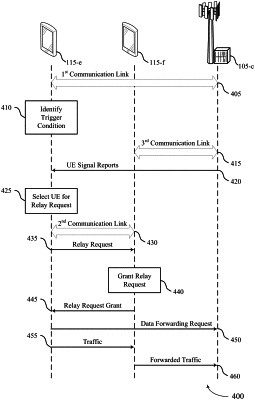| CPC H04W 72/0473 (2013.01) [H04W 72/56 (2023.01); H04W 76/11 (2018.02); H04W 76/14 (2018.02); H04W 92/18 (2013.01)] | 25 Claims |

|
1. A method for wireless communication by a first user equipment (UE), comprising:
monitoring one or more parameters associated with a trigger condition, wherein the trigger condition is associated with a first communication link between the first UE and a network device;
receiving a signal report from a second UE, wherein the signal report indicates one or more parameters associated with a third communication link between the second UE and the network device, and wherein the one or more parameters associated with the third communication link comprise a received signal strength indicator, a reference signal received power, a reference signal received quality, or any combination thereof;
detecting an occurrence of the trigger condition based at least in part on the monitoring and the signal report;
establishing a sidelink communication link, the sidelink communication comprising a second communication link between the first UE and the second UE;
transmitting a relay request to the second UE via the sidelink communication link based at least in part on the trigger condition, wherein the relay request comprises a request for the second UE to relay communications between the first UE and the network device; and
communicating with the network device via the sidelink communication link based at least in part on the relay request.
|